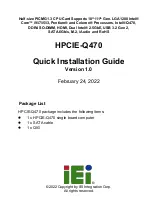
PPC7A Product Manual
Functional Description
8-4
1
st
Edition
Resetting the PPC7A
There are two types of reset that may be applied to the PPC7A: ‘Hard’ and ‘Soft’.
Hard Reset
This causes the processor to begin executing code from address 0xFFF0 0100 in the System FLASH. By
fitting a hardware jumper (E2), the System FLASH addresses may be passed to the VME instead of the
FLASH. In this way, the processor can begin executing code from a VME source.
The following table summarizes events that may cause a hard reset:
S
OURCE
A
CTION
S
YSRESET
~
G
ENERATION
Power-on
Yes
Received SYSRESET~
No
Watchdog time-out
Front-panel hard reset
Hardware
Events
P0 (where fitted) hard reset
signal (pin C1)
Hard reset all devices
If System
Controller
SW_LRST bit
VCSR bit
Hard reset excluding
VMEbus Interface
No
Software
Events
SW_SYSRESET bit
Hard reset if System
Controller
If System
Controller
The SW_LRST, VCSR and SW_SYSRESET bits are located in the Universe II PCI-VME bridge.
The front panel hard reset may be disabled under software control or by fitting hardware jumper E14.
$
Note:
Integrity of SDRAM data cannot be guaranteed during hard reset, since the memory controller is reset
and SDRAM refresh disabled. Similarly, integrity of FLASH or EEPROM data cannot be guaranteed if a
hard reset occurs during a FLASH or EEPROM write cycle, respectively.
See the SDRAM section for SDRAM initialization requirements following a hard reset.
Artisan Technology Group - Quality Instrumentation ... Guaranteed | (888) 88-SOURCE | www.artisantg.com










































